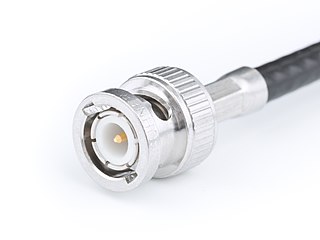
The BNC connector is a miniature quick connect/disconnect radio frequency connector used for coaxial cable. It is designed to maintain the same characteristic impedance of the cable, with 50 ohm and 75 ohm types being made. It is usually applied for video and radio frequency connections up to about 2 GHz and up to 500 volts. The connector has a twist to lock design with two lugs in the female portion of the connector engaging a slot in the shell of the male portion. The type was introduced on military radio equipment in the 1940s and has since become widely applied in radio systems, and is a common type of video connector. Similar radio-frequency connectors differ in dimensions and attachment features, and may allow for higher voltages, higher frequencies, or three-wire connections.

The N connector is a threaded, weatherproof, medium-size RF connector used to join coaxial cables. It was one of the first connectors capable of carrying microwave-frequency signals, and was invented in the 1940s by Paul Neill of Bell Labs, after whom the connector is named.
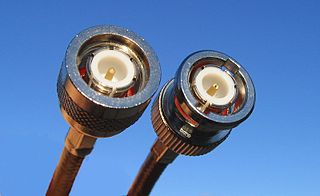
The TNC connector is a threaded version of the BNC connector.
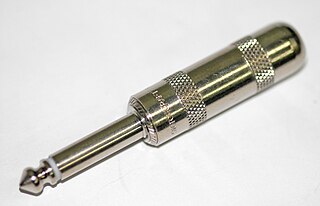
A phone connector, also known as phone jack, audio jack, headphone jack or jack plug, is a family of electrical connectors typically used for analog audio signals. A plug, the "male" connector, is inserted into the jack, the "female" connector.

The D-subminiature or D-sub is a common type of electrical connector. They are named for their characteristic D-shaped metal shield. When they were introduced, D-subs were among the smallest connectors used on computer systems.

The F connector is a coaxial RF connector commonly used for "over the air" terrestrial television, cable television and universally for satellite television and cable modems, usually with RG-6/U cable or with RG-59/U cable.
Rolled homogeneous armour (RHA) is a type of vehicle armour made of a single steel composition hot-rolled to improve its material characteristics, as opposed to layered or cemented armour. Its first common application was in tanks. After World War II, it began to fall out of use on main battle tanks and other armoured fighting vehicles intended to see front-line combat as new anti-tank weapon technologies were developed which were capable of relatively easily penetrating rolled homogeneous armour plating even of significant thickness.

The C connector is a type of RF connector used for terminating coaxial cable. The interface specifications for the C and many other connectors are referenced in MIL-STD-348. The connector uses two-stud bayonet-type locks. The C connector was invented by Amphenol engineer Carl Concelman. It is weatherproof without being overly bulky. The mating arrangement is similar to that of the BNC connector. It can be used up to 11 GHz, and is rated for up to 1500 volts.

SMA connectors are semi-precision coaxial RF connectors developed in the 1960s as a minimal connector interface for coaxial cable with a screw-type coupling mechanism. The connector has a 50 Ω impedance. SMA was originally designed for use from DC (0 Hz) to 12 GHz, however this has been extended over time and variants are available to 18 GHz and 26.5 GHz. There are also mechanically compatible connectors such as the K-connector which operate up to 40 GHz. The SMA connector is most commonly used in microwave systems, hand-held radio and mobile telephone antennas and, more recently, with WiFi antenna systems and USB software-defined radio dongles. It is also commonly used in radio astronomy, particularly at higher frequencies (5 GHz+).

SMC connectors are coaxial RF connectors developed in the 1960s. The interface specifications for the SMC and many other connectors are referenced in MIL-STD-348. They use a #10-32 UNF threaded interface. They offer electrical performance from direct current (DC) to 4 GHz. Some extended performance versions are rated to 10 GHz. The normally free part of a SMC connector that has a socket for the centre contact are the female connectors. The normally fixed part SMC connectors that has a pin for the centre contact are the male connectors. This is the reverse of most RF connectors. SMC jack connectors have an external thread while SMC plug connectors have the mating hex nut. The contact dimensions are identical to the snap-fit SMB. Available in 50 ohm and 75 ohm characteristic impedance, they provide an interconnect means for small form factor coaxial cables and printed circuit boards where small footprint is important.
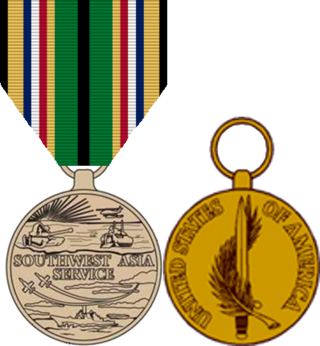
The Southwest Asia Service Medal is a military award of the United States Armed Forces which was created by order of President George H.W. Bush on March 12, 1991. The award is intended to recognize those military service members who performed duty as part of the Persian Gulf War and for a time thereafter. The medal was designed by Nadine Russell of the Army's Institute of Heraldry. The colors of the ribbon are tan, representing sand, with the black, white, red, blue, and green colors symbolizing the colors of coalition countries' national flags.
JP-8, or JP8, is a jet fuel, specified and used widely by the US military. It is specified by MIL-DTL-83133 and British Defence Standard 91-87, and similar to commercial aviation's Jet A-1, but with the addition of corrosion inhibitor and anti-icing additives.

The term Amphenol connector refers to various electronics connectors that are introduced, or made primarily by Amphenol Corp. Depending on the area of electronics concerned, it may refer specifically to:

MIL-STD-810, U.S. Department of Defense Test Method Standard, Environmental Engineering Considerations and Laboratory Tests, is a United States Military Standard that emphasizes tailoring an equipment's environmental design and test limits to the conditions that it will experience throughout its service life, and establishing chamber test methods that replicate the effects of environments on the equipment rather than imitating the environments themselves. Although prepared specifically for U.S. military applications, the standard is often applied for commercial products as well.
EIA RF Connectors are used to connect two items of high power radio frequency rigid or semi-rigid (flexline) coaxial transmission line. Typically these are only required in very high power transmitting installations where the feedline diameters may be several inches. The connectors are always female, requiring a male coupling element or bullet to make the connection. The EIA under the Electronic Components Industry Association, are responsible for a number of standard imperial connector sizes.

Electrical or fiber-optic connectors used by U.S. Department of Defense were originally developed in the 1930s for severe aeronautical and tactical service applications, and the Type "AN" (Army-Navy) series set the standard for modern military circular connectors. These connectors, and their evolutionary derivatives, are often called Military Standard, "MIL-STD", or (informally) "MIL-SPEC" or sometimes "MS" connectors. They are now used in aerospace, industrial, marine, and even automotive commercial applications.

MIL-DTL-5015 is a United States Military Standard which covers heavy-duty circular electrical connectors with soldered or crimped contacts. They are used for both digital and analog signals, as well as power distribution, and are common in various fields, including defense, aerospace, and industrial machinery. The connectors are particularly versatile and reliable, and due to their prevalence, relatively inexpensive.

A concentric twinax connector has a center pin and a cylindrical intermediate contact as compared to a dual polarized pin type.
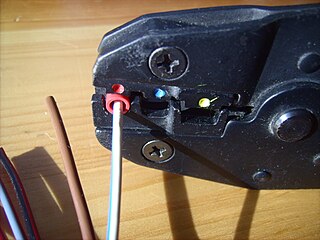
An electrical crimp is a type of solderless electrical connection which uses physical pressure to join the contacts.
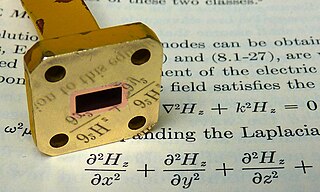
A waveguide flange is a connector for joining sections of waveguide, and is essentially the same as a pipe flange—a waveguide, in the context of this article, being a hollow metal conduit for microwave energy. The connecting face of the flange is either square, circular or, rectangular. The connection between a pair of flanges is usually made with four or more bolts, though alternative mechanisms, such as a threaded collar, may be used where there is a need for rapid assembly and disassembly. Dowel pins are sometimes used in addition to bolts, to ensure accurate alignment, particularly for very small waveguides.

















